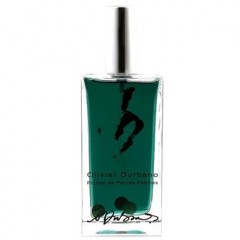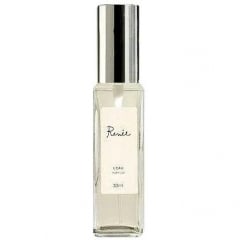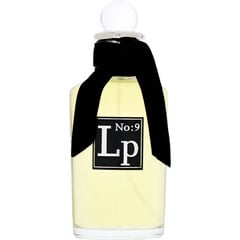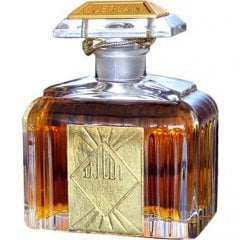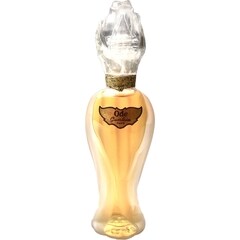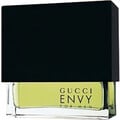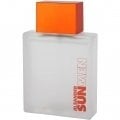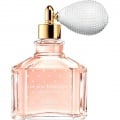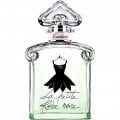
DemonHead
Reviews
Filter & sort
A snapshot of China
In ancient Chinese Dynasties, Jade was revered as the imperial gem... favoured by the high-ranking members of the imperial family as an ornamental stone. Varieties of the stone can be found in hues from white, through pink to black, but the highly prized emerald green jade commonly appears in history, used in elaborate ceremonial pieces, and hand-fashioned by skilled artisans into objets d'art.
On a school trip to China in the late 80's, I returned home with several jade souvenirs... mostly trinkets really, but it is the very nature of the stone that seems to embody the country's vast history. In a bygone era, when nomads travelled the Silk Road, it was considered more valuable than gold. It is little wonder then, that jeweller/perfumer Olivier Durbano has chosen this esteemed cabochon for inclusion in his seven "stone poems".
This being said, when Jade is first applied, I do not immediately garner a sense of noble opulence as perhaps I had expected. Instead, I get a strong sense of the China that might have existed in the early 1900's - when her glory days were over, and she was a country controlled by many European nations. After several wars, and with control over most of her lucrative sea-ports lost to the Europeans, this invited foreign trade and residence. China was influenced by external powers, and the wishes of the Chinese themselves often ignored. This cohabitation meant a swing in Chinese culture was at hand, much to the resentment of the Chinese. So, how is this translated into perfume? I hear you ask... well, Jade is a clever marriage between European convention and Far Eastern tradition.
As one might well imagine, judging the vivid green colour of the juice; opening notes are initially rather medicinal... a sharp stab of lush wet mint, followed by the biting aroma of bitter green tea leaves. Whilst these accords share a starring role and have remarkable tenacity, one can also distinguish a scattering of star anise and a curl of aromatic cassia. The experience is rather like a visit to a traditional Chinese herbalist whose walls are lined with antique wooden apothecary drawers; the contents of which are collected and bundled together in rice-paper packages, and carefully tied with string. One can also identify some delicate florals and dusty iris germinating at the heart, though these are as fine as Chinese silk and transparent as hand-made paper lanterns. They merely cast light on the understated vetiver/patchouli base that lies at the floor of the perfume, and whose accords soar and fall sharply like rugged Chinese mountains.
People familiar with Durbano's previous offerings might wonder if he has captured the spirit of jade (the stone) with the same measure of excellence as he has with his other stone poems. His approach to this scent marks a shift in style: for starters, the resinous frankincense/incense accords which were at the heart of all 3 previous perfumes (ones that I felt lend the earthy/mineralic qualities to his work); are now absent. This being said, I don't feel this diminishes his interpretation of jade. After all, the Chinese use jade less in its raw mineral form, and more as a polished and finished piece. If one could experience the taste of a smooth green jade cabochon, it would taste just like this perfume smells. There are nuances of the Far East, and shades of traditional European perfumery that make Jade an enchanting scent with a wonderful vintage twist.
On a school trip to China in the late 80's, I returned home with several jade souvenirs... mostly trinkets really, but it is the very nature of the stone that seems to embody the country's vast history. In a bygone era, when nomads travelled the Silk Road, it was considered more valuable than gold. It is little wonder then, that jeweller/perfumer Olivier Durbano has chosen this esteemed cabochon for inclusion in his seven "stone poems".
This being said, when Jade is first applied, I do not immediately garner a sense of noble opulence as perhaps I had expected. Instead, I get a strong sense of the China that might have existed in the early 1900's - when her glory days were over, and she was a country controlled by many European nations. After several wars, and with control over most of her lucrative sea-ports lost to the Europeans, this invited foreign trade and residence. China was influenced by external powers, and the wishes of the Chinese themselves often ignored. This cohabitation meant a swing in Chinese culture was at hand, much to the resentment of the Chinese. So, how is this translated into perfume? I hear you ask... well, Jade is a clever marriage between European convention and Far Eastern tradition.
As one might well imagine, judging the vivid green colour of the juice; opening notes are initially rather medicinal... a sharp stab of lush wet mint, followed by the biting aroma of bitter green tea leaves. Whilst these accords share a starring role and have remarkable tenacity, one can also distinguish a scattering of star anise and a curl of aromatic cassia. The experience is rather like a visit to a traditional Chinese herbalist whose walls are lined with antique wooden apothecary drawers; the contents of which are collected and bundled together in rice-paper packages, and carefully tied with string. One can also identify some delicate florals and dusty iris germinating at the heart, though these are as fine as Chinese silk and transparent as hand-made paper lanterns. They merely cast light on the understated vetiver/patchouli base that lies at the floor of the perfume, and whose accords soar and fall sharply like rugged Chinese mountains.
People familiar with Durbano's previous offerings might wonder if he has captured the spirit of jade (the stone) with the same measure of excellence as he has with his other stone poems. His approach to this scent marks a shift in style: for starters, the resinous frankincense/incense accords which were at the heart of all 3 previous perfumes (ones that I felt lend the earthy/mineralic qualities to his work); are now absent. This being said, I don't feel this diminishes his interpretation of jade. After all, the Chinese use jade less in its raw mineral form, and more as a polished and finished piece. If one could experience the taste of a smooth green jade cabochon, it would taste just like this perfume smells. There are nuances of the Far East, and shades of traditional European perfumery that make Jade an enchanting scent with a wonderful vintage twist.
Etherial & clean
In perfumery, the element of water or "l'eau" is often reinterpreted by perfumers who seek to produce a scent that is sparklingly refreshing. Many of the world's finest noses have tried to capture the essence of water through olfaction. Surprisingly, the virtually unknown Australian boutique fragrance house Renée have made a regal effort in achieving just this. Simply titled L'eau, Renée offers an ethereal blend of spearmint, basil and mint - which is as crisp as fresh spring water - over a heart and base of rose, violet, nutmeg and dewy oakmoss. The result is a tender scent that is somehow both enlivening and calming.
I find this an interesting study of the 'water' concept. Perhaps one might say that there is no truth to this perfume... that its components are diverse and arbitrary and nothing has been "appended" from the true elemental source. But water, ultimately, is odourless. So, with unabashed artistic freedom, I believe that L'eau embodies the true poetry and romance of a real summer thundershower.
I find this an interesting study of the 'water' concept. Perhaps one might say that there is no truth to this perfume... that its components are diverse and arbitrary and nothing has been "appended" from the true elemental source. But water, ultimately, is odourless. So, with unabashed artistic freedom, I believe that L'eau embodies the true poetry and romance of a real summer thundershower.
Top hats and tails...
Shimmering citrus top notes veil deep, rich, spicy heart and base accords... zesty bergamot, lemon and mandarin merge with a humming blend of rosemary, black pepper, warm cinnamon and smokey amber - the total sum of which tends to prickle at the back of your nose. The opening sensation is rather like inhaling the aroma of scotch and dry ginger ale. But with time, one can detect the delicate blend of warm clove, mint-like geranium, dry vetiver and fragrant sandalwood. This is a scent to be cherished as something timeless, sophisticated and elegant.
One cant help but feel transported back to Victorian England when wearing this abandoned treasure... dressed in top hat and tails, stepping out of coal-black carriages with white gloves and silver-tipped ebony canes; Love Potion No:9 hanging in the air overhead like a shiny black raven.
A signature scent of mine, which possesses a celebratory air. Glorious.
One cant help but feel transported back to Victorian England when wearing this abandoned treasure... dressed in top hat and tails, stepping out of coal-black carriages with white gloves and silver-tipped ebony canes; Love Potion No:9 hanging in the air overhead like a shiny black raven.
A signature scent of mine, which possesses a celebratory air. Glorious.
1 Comment
Guerlain Djedi: a brief history and review
Egyptology must have been to the 1920's that which features like Harry Potter and Twilight are to us today. Howard Carter's monumental discovery of Tutankhamun's tomb in 1923 directly influenced the global psyche; much in the same way as teenage vampires have penetrated our cultural consciousness in 2013. But whilst we in the here and now must suffer the commerce surrounding pasty-skinned blood-suckers and battling werewolves, our great-grandparents actually drew breath during an age of colossal cultural, anthropological and historical value. Oh, how I envy them!
The magic and mystique of ancient Egyptian dynasties certainly served as the inspiration behind Guerlain's Djedi: a captivating and rare chypre oriental perfume created in 1926, just three years after Carter's significant find. Djedi was presented in a flacon designed the sculptor Georges Chevalier and produced by Baccarat in 60ml, 125ml and 250ml sizes. The contours of the bottle (with its tall, ridged sides and gently tapering rectangular ground glass stopper) is distinctly Art Deco in style; but also suggests the form of a golden sarcophagus with its lid being raised.
Djedi was marketed in this flacon until the end of the 1950's, and also for a short time in an exceedingly rare quadrilobe presentation. It was re-issued in 1996 in celebration if its 70th year as a limited run of 1000 numbered Baccarat bottles created from the original 1920's 60ml mould.
Before I go on to review this scent, first a little background: the name Djedi is derived from references found in the ancient Egyptian Book of the Dead where the Djed is described as a pillar which was raised to maintain universal stability, balance and continuity. It is the invisible cosmic axis or "world tree" around which everything revolves... it separates the earth from the sky; and matter from spirit. The Djedi are the ancients attributed to spreading this awareness... often referred to or portrayed as formidable primeval magicians. Djedi are mentioned in historical tales of Egypt as possessing tremendous mystical powers; their shamanistic practices, still an enigma.
I feel this information important to mention as it translates directly to the perfume itself. Until Djedi's launch in 1926, Guerlain have perhaps never before nor ever since created a perfume which so precisely and faithfully depicts an age of esoteric antiquity.
Djedi the perfume is less luminous than other Guerlain offerings. It serves as a period piece honouring the ancient past... perhaps a past as archaic as the pyramids themselves. Whilst a very complex perfume, Djedi is somehow as basic and primordial as dirt and stone - the basic building blocks of man. It is earthy, elemental and possesses a certain olfactory temperature - a feeling of dwindling warmth like that thrown out by the dying embers of a bonfire. It darts back and forth across the invisible boundary of light where amber warmth meets the cold black of night. Djedi isn't 'pretty' like her sisters; instead, she perhaps represents the disfigured sibling who spends her life residing in the gloom. Something is "off". Sinister. Agonizing.
Djedi is composed using a very dry vetiver: one that furnishes the perfume with a parched, arid vibe. Combined with a measure of civet, patchouli, oakmoss and musk, this vetiver lends a dank, musty quality that evokes sensations of being deep underground; where narrow stone corridors trap the air that has not shifted over the millennia. There is a sense of being unable to catch ones breath. A commanding leather facet also brings with it a feeling of antiquity - I immediately imagine dusty animal skins stitched together to fashion a tattered ceremonial shroud. I feel as if I am witnessing the ghosts assemble at an ancient entombment; the atmosphere palpable with a sense of grief, sorrow and despair.
My nose struggles to reach for the rose and jasmine said to reside at the heart of Djedi, but Im sure they are there. Perhaps, as this olfactory requiem unfolds, my senses too have become impervious to the beauty that surrounds us all during a time of lamentation. Whilst I cannot pinpoint these individual notes, I do recognise what this resolute floral facet brings to the fabric of this perfume, and that is a contemplative moment to look back on an age of immeasurable glory and resplendence. I suspect it was Jacques Guerlain's wish to create Djedi so the world could recognise the rise and fall of one of the world's most powerful and beautiful ancient empires.
Djedi - being one of the rarest and most difficult to source of all Guerlain fragrances - threatens to be lost again to the sands of time. One might hope that the Djed is raised again, linking the material world with the esoteric one, and our prayers of resurrection are answered.
The magic and mystique of ancient Egyptian dynasties certainly served as the inspiration behind Guerlain's Djedi: a captivating and rare chypre oriental perfume created in 1926, just three years after Carter's significant find. Djedi was presented in a flacon designed the sculptor Georges Chevalier and produced by Baccarat in 60ml, 125ml and 250ml sizes. The contours of the bottle (with its tall, ridged sides and gently tapering rectangular ground glass stopper) is distinctly Art Deco in style; but also suggests the form of a golden sarcophagus with its lid being raised.
Djedi was marketed in this flacon until the end of the 1950's, and also for a short time in an exceedingly rare quadrilobe presentation. It was re-issued in 1996 in celebration if its 70th year as a limited run of 1000 numbered Baccarat bottles created from the original 1920's 60ml mould.
Before I go on to review this scent, first a little background: the name Djedi is derived from references found in the ancient Egyptian Book of the Dead where the Djed is described as a pillar which was raised to maintain universal stability, balance and continuity. It is the invisible cosmic axis or "world tree" around which everything revolves... it separates the earth from the sky; and matter from spirit. The Djedi are the ancients attributed to spreading this awareness... often referred to or portrayed as formidable primeval magicians. Djedi are mentioned in historical tales of Egypt as possessing tremendous mystical powers; their shamanistic practices, still an enigma.
I feel this information important to mention as it translates directly to the perfume itself. Until Djedi's launch in 1926, Guerlain have perhaps never before nor ever since created a perfume which so precisely and faithfully depicts an age of esoteric antiquity.
Djedi the perfume is less luminous than other Guerlain offerings. It serves as a period piece honouring the ancient past... perhaps a past as archaic as the pyramids themselves. Whilst a very complex perfume, Djedi is somehow as basic and primordial as dirt and stone - the basic building blocks of man. It is earthy, elemental and possesses a certain olfactory temperature - a feeling of dwindling warmth like that thrown out by the dying embers of a bonfire. It darts back and forth across the invisible boundary of light where amber warmth meets the cold black of night. Djedi isn't 'pretty' like her sisters; instead, she perhaps represents the disfigured sibling who spends her life residing in the gloom. Something is "off". Sinister. Agonizing.
Djedi is composed using a very dry vetiver: one that furnishes the perfume with a parched, arid vibe. Combined with a measure of civet, patchouli, oakmoss and musk, this vetiver lends a dank, musty quality that evokes sensations of being deep underground; where narrow stone corridors trap the air that has not shifted over the millennia. There is a sense of being unable to catch ones breath. A commanding leather facet also brings with it a feeling of antiquity - I immediately imagine dusty animal skins stitched together to fashion a tattered ceremonial shroud. I feel as if I am witnessing the ghosts assemble at an ancient entombment; the atmosphere palpable with a sense of grief, sorrow and despair.
My nose struggles to reach for the rose and jasmine said to reside at the heart of Djedi, but Im sure they are there. Perhaps, as this olfactory requiem unfolds, my senses too have become impervious to the beauty that surrounds us all during a time of lamentation. Whilst I cannot pinpoint these individual notes, I do recognise what this resolute floral facet brings to the fabric of this perfume, and that is a contemplative moment to look back on an age of immeasurable glory and resplendence. I suspect it was Jacques Guerlain's wish to create Djedi so the world could recognise the rise and fall of one of the world's most powerful and beautiful ancient empires.
Djedi - being one of the rarest and most difficult to source of all Guerlain fragrances - threatens to be lost again to the sands of time. One might hope that the Djed is raised again, linking the material world with the esoteric one, and our prayers of resurrection are answered.
1 Comment
Ode - a libidinous floral lost to time.
It is no coincidence that the last perfume ever created by Jacques Guerlain was called "Ode", as it represented an olfactory milestone in his career; the final perfume poem in his body of work which spanned 65 years. It also marked the very first efforts of his then 18-year old grandson Jean Paul Guerlain who was set to ascend to the throne at 68 Champs Élysées.
Ode also marked a turning point in the style of perfume that was to emerge from the house of Guerlain in the decades to come. Jacques Guerlain's somewhat sombre, mature creations launched between the two world wars were soon to replaced with arguably more spirited, dynamic works of art under an enthusiastic young Jean Paul's direction.
I find the contrast in Ode's advertising noteworthy too. In one regard, the advertising almost has a funerary feel... an ashen harp-playing cherub is depicted perhaps mourning the end of an era; whilst in striking contrast, Ode is portrayed as being energetic and new-fangled against violet hues and bushels of verdant green. This visual inconsistency illustrates a perfume perhaps standing at the crossroads of tradition and modernity... one whose purpose was maybe to appeal to an existing, more mature market, whilst at the same time, was establishing a brand new one.
Ode is a bright floral perfume with one foot planted in the past, and one foot planted in the future. In 2013, we can now review all the Guerlain creations of the 20th century, and I can see where Ode embraced classic perfume styles with its use of aldehydes, jasmine and rose, but also gives us a taste of things to come... I sense a prelude of other Jean Paul Guerlain prefumes sitting just over the horizon: the likes of Chant d'Arômes, Parure and Nahema.
Ode is a rich floral that has been likened to Jean Patou's Joy, though I personally don't feel it bares much of a resemblance. Indeed, it does focus on jasmine and velvety rose, but Ode is pregnant with other surprises... I glean a very green accord lying beneath the floral fanfare in the opening spritz... a crisp green/floral accord much like muguet. This brisk virescent facet synchronises well with the aldehydes and lends a dry piquancy to the perfume. There is a slightly dirty facet too which I would attribute to tuberose... a fleeting sensation of carnal liveliness. My nose also struggles to pinpoint the cause of a rather transitory but delightful 'rubbery' facet... perhaps there is a whisper of hyacinth unfurling within. Some time later, the rose/jasmine duo recede a little whilst the aldehydes turn to powder, and a creamy vanilla base becomes apparent... there is a hint of muskiness in the base that shifts the honeyed nature of the vanilla in a more libidinous direction.
To my mind, Jacques and Jean Paul not only intended Ode to memorialise the efforts of a perfume master and mark the inauguration of a new perfume nose, but also to act as an olfactory aria to femininity itself. Now lost to time (despite ongoing rumours of a possible resurrection), Ode remains the one perfume collaboration between two perfume greats; a moving and impassioned marriage of ideas, and - of course - ages.
Ode also marked a turning point in the style of perfume that was to emerge from the house of Guerlain in the decades to come. Jacques Guerlain's somewhat sombre, mature creations launched between the two world wars were soon to replaced with arguably more spirited, dynamic works of art under an enthusiastic young Jean Paul's direction.
I find the contrast in Ode's advertising noteworthy too. In one regard, the advertising almost has a funerary feel... an ashen harp-playing cherub is depicted perhaps mourning the end of an era; whilst in striking contrast, Ode is portrayed as being energetic and new-fangled against violet hues and bushels of verdant green. This visual inconsistency illustrates a perfume perhaps standing at the crossroads of tradition and modernity... one whose purpose was maybe to appeal to an existing, more mature market, whilst at the same time, was establishing a brand new one.
Ode is a bright floral perfume with one foot planted in the past, and one foot planted in the future. In 2013, we can now review all the Guerlain creations of the 20th century, and I can see where Ode embraced classic perfume styles with its use of aldehydes, jasmine and rose, but also gives us a taste of things to come... I sense a prelude of other Jean Paul Guerlain prefumes sitting just over the horizon: the likes of Chant d'Arômes, Parure and Nahema.
Ode is a rich floral that has been likened to Jean Patou's Joy, though I personally don't feel it bares much of a resemblance. Indeed, it does focus on jasmine and velvety rose, but Ode is pregnant with other surprises... I glean a very green accord lying beneath the floral fanfare in the opening spritz... a crisp green/floral accord much like muguet. This brisk virescent facet synchronises well with the aldehydes and lends a dry piquancy to the perfume. There is a slightly dirty facet too which I would attribute to tuberose... a fleeting sensation of carnal liveliness. My nose also struggles to pinpoint the cause of a rather transitory but delightful 'rubbery' facet... perhaps there is a whisper of hyacinth unfurling within. Some time later, the rose/jasmine duo recede a little whilst the aldehydes turn to powder, and a creamy vanilla base becomes apparent... there is a hint of muskiness in the base that shifts the honeyed nature of the vanilla in a more libidinous direction.
To my mind, Jacques and Jean Paul not only intended Ode to memorialise the efforts of a perfume master and mark the inauguration of a new perfume nose, but also to act as an olfactory aria to femininity itself. Now lost to time (despite ongoing rumours of a possible resurrection), Ode remains the one perfume collaboration between two perfume greats; a moving and impassioned marriage of ideas, and - of course - ages.

 DemonHead
DemonHead